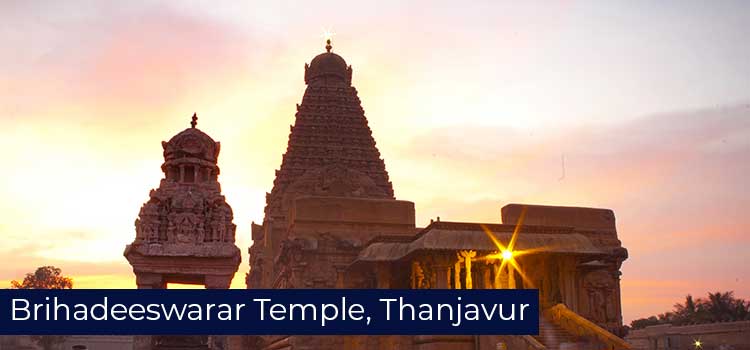Brihadeeswarar Temple, Thanjavur

Thanjavur, a city in Tamil Nadu located in the delta region watered by the Cauvery river, is renowned for its art, religion, and architecture. It is also called the ‘Rice bowl of Tamil Nadu’. Besides, it is home to the Great Living Chola temples, for which it earned the tag of a UNESCO World Heritage site. The most imposing of these marvelous temples is the more than 1000-year old Brihadeeswara temple, which attracts devotees and tourists from many parts of the world. This temple is also called Dakshina Meru, and during the Chola era, it was known as Rajarajeswaram. Other names for it are Periya kovil (Big temple) and Peruvudaiyar temple. Dedicated to Lord Shiva, it is one of the biggest temples in Tamil Nadu and is considered to be one among the finest specimens of Dravidian architecture. It was built by emperor Arulmozhivarman or Raja Raja Chola I in 1010 AD. The Cholas were one of the longest-ruling dynasties and most powerful dynasties of ancient India. Brihadeeshvaran means the ‘Big Lord’ in Tamil. The Hindu traditions of Shaivism, Shaktism, and Vaishnavism are incorporated in Brihadeeshwara.
Special features of the temple
The temple has been built entirely in granite. Over 130, 000 tons of granite were used in its making. Its spell-binding architecture and design have many unique and intriguing features. For instance, the Shiva Lingam in the sanctum sanctorum is one of the largest monolithic structures of its kind in the country. One distinctive architectural feature of this temple is that its shadow never falls on the ground at noon. This mystery attracts thousands of tourists and architecture-lovers from far and wide to glimpse the phenomenon and unravel the mystery behind it. Also, in most of the south Indian temples, the gopurams or gates tend to be taller than the Vimana or main temple tower or vimana. But here, it’s just the opposite. The temple’s 16-storeyed vimana is the tallest in the world, at 66 m in height. The temple, probably the greatest creation of the Chola era, can be seen from any part of Thanjavur, perhaps the only temple with this characteristic. It is said that Raja Raja Chola was inspired to build it after seeing the Pallava Rajasimha temples in Kancheepuram. Not just architecture, it also testifies to the Chola artisans’ brilliance in sculpture, painting, and bronze casting.
The temple complex has five sections. They include the sanctum sanctorum and Vimana, Nandi hall, assembly hall (mukhamandapam), gathering hall (mahamandapam), and prakara (pavilion).. The presiding deity is Shiva, who is worshipped as Karuvarai, which means ‘womb chamber’. There are some beautiful shrines for Shiva’s consort, Parvati, their sons Murugan and Ganesha, Shiva’s mount, Nandi, Dakshinamurti, Varahi, Subrahmanyar, Chandeshwara, and Sabhapati. The temple is the site where the brass Nataraja idol was commissioned in the 11th century for the first time. The walls, ceilings, and floors have magnificent sculptures, ornate inscriptions, and exquisite murals.
The idol of Shiva installed here is in his dancing pose, called Nataraja. The temple stands like a fortress on the shores of a river. Its historical and cultural value is immense. The 216 ft tall Vimana is the major attraction of the temple, and it was built above the sanctum. It can be seen by people entering the city. Another breathtaking feature is the magnificent Nandi statue at the temple entrance. It is two meters in height, two-and-half meters in width, and six meters in length, and weighs 20 tons! The statue has been built from a single granite stone. Various Bharathanatyam (a classical dance of south India) postures have been carved on the outer walls of the temple’s upper story. Several shrines were added to the temple by later rulers like the Pandyas, the Vijayanagara rulers, and also the Marathas too.
Another distinctive feature of the temple is its musical pillars. When tapped, they produce different sounds. This grand and imposing temple is more than a spiritual abode, it is a testament to the architectural vision of a great empire.
Maha Shivaratri celebrations at the temple
Shiva is the principal deity here, and he is represented by a giant stone Lingam inside the sanctum. The deity is known as Peruvudaiyar. Shivaratri and Maha Shivaratri, the great night of Shiva, are celebrated at the temple. Poojas, arti, and Abishekams are performed for the deity during Maha Shivaratri. Hordes of devotees come to the temple from far and near to witness the celebrations. The worship continues long into the night. Devotees make various offerings of flowers, fruits, coconut, dhatura, etc., to the Lingam. Chanting of Shiva Mantras, Bhajans, and Stotras, reciting Shiva Purana, observing vrat, and meditation, are some of the activities that devotees engage in on this day.

Huawei HC-711 - Certification For a Great Career
- Gearing your homeschool classes about Howard Gardners several intelligences heightens the two similarly generate and potential mastery.

Indy 500: Fernando Alonso walking tightest of tight ropes, says Dario Franchitti
- This Sunday, the two-time Formula One world champion will line up on the grid at the Indianapolis 50

An Australian man dies in alleged ax attack after road rage incident
- The attack happened at about 6 p.m. and followed a road rage incident in the same suburb of Melbourn

Mother becomes first person found guilty of FGM in UK tineid
- The Central Criminal Court confirmed to CNN that a 37-year-old Ugandan woman from Walthamstow, Londo
